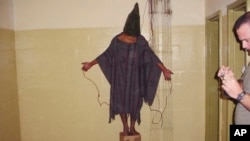Your current location:HOME >travel >20 years later, Abu Ghraib detainees get their day in US court 正文
TIME:2024-04-30 04:03:23 Source: Internet compilationEdit:travel
ALEXANDRIA, Va. —Twenty years ago this month, photos of abused prisoners and smiling U.S. soldiers g
Twenty years ago this month, photos of abused prisoners and smiling U.S. soldiers guarding them at Iraq's Abu Ghraib prison were released, shocking the world.
Now, three survivors of Abu Ghraib will finally get their day in U.S. court against the military contractor they hold responsible for their mistreatment.
The trial is scheduled to begin Monday in U.S. District Court in Alexandria, and it will be the first time that Abu Ghraib survivors are able to bring their claims of torture to a U.S. jury, said Baher Azmy, a lawyer with the Center for Constitutional Rights representing the plaintiffs.
The defendant in the civil suit, CACI, supplied the interrogators who worked at the prison. The Virginia-based contractor denies any wrongdoing and has emphasized throughout 16 years of litigation that its employees are not alleged to have inflicted any abuse on any of the plaintiffs in the case.
The plaintiffs, though, seek to hold CACI responsible for setting the conditions that resulted in the torture they endured, citing evidence in government investigations that CACI contractors instructed military police to "soften up" detainees for their interrogations.
Retired Army Gen. Antonio Taguba, who led an investigation into the Abu Ghraib scandal, is among those expected to testify. His inquiry concluded that at least one CACI interrogator should be held accountable for instructing military police to set conditions that amounted to physical abuse.
There is little dispute that the abuse was horrific. The photos released in 2004 showed naked prisoners stacked into pyramids or dragged by leashes. Some photos had a soldier smiling and giving a thumbs up while posing next to a corpse, or detainees being threatened with dogs, or hooded and attached to electrical wires.
The plaintiffs cannot be clearly identified in any of the infamous images, but their descriptions of mistreatment are unnerving.

Oracle bone script art exhibition unveiled in South Africa2024-04-30 03:56
Advocates attack removal of climate change from government's draft transport policy2024-04-30 03:15
Fascinating map reveals the WORST reviewed three2024-04-30 02:38
Inside the £1602024-04-30 02:37
Chinese scientists use machine learning for precise Antarctic sea ice prediction2024-04-30 02:29
Government backs trust tax rate exemptions2024-04-30 02:23
Net tightens on Bolsonaro as police seize passport in coup probe2024-04-30 01:42
Five of the world's most arduous bus journeys, from a 52024-04-30 01:39
English Premier League takes another step toward introducing a spending cap2024-04-30 01:35
I took a trip on America's CHEAPEST cruise2024-04-30 01:27
FAU's Vladislav Goldin to join Dusty May at Michigan, pulls name out of NBA draft2024-04-30 03:59
First look: Alton Towers' 50mph Nemesis rollercoaster is unveiled to the public with a brand2024-04-30 03:57
Grab a key (literally) and unlock the secrets of Denbigh, a forgotten corner of North Wales2024-04-30 03:46
The world's best 50 cities in 2024 ranked by Time Out2024-04-30 03:02
Rolling Stones show no signs of slowing during latest tour in Texas2024-04-30 02:59
Singapore2024-04-30 02:55
From a jaguar pouncing on an alligator to a spectacular 'flying saucer cloud': Jaw2024-04-30 02:40
Don't be a tourist bored! Fascinating map reveals ONE THOUSAND amazing things to do, see2024-04-30 01:48
Oracle bone script art exhibition unveiled in South Africa2024-04-30 01:47
The future of entertainment? Inside the world's first 'Hologram Zoo' in Australia2024-04-30 01:29